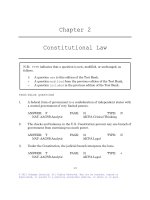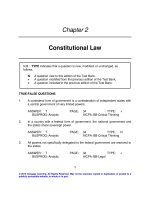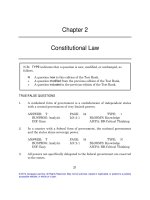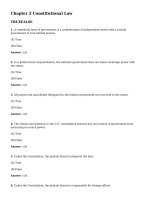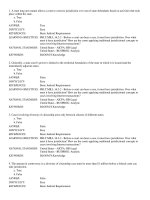Bus law today 9th ed ch22
Bạn đang xem bản rút gọn của tài liệu. Xem và tải ngay bản đầy đủ của tài liệu tại đây (199.08 KB, 28 trang )
BUSINESS LAW TODAY
Essentials 9th Ed.
Roger LeRoy Miller - Institute for University Studies, Arlington, Texas
Gaylord A. Jentz - University of Texas at Austin, Emeritus
Chapter
22
Promoting Competition
© 2011 Cengage Learning. All Rights Reserved. May not be copied, scanned, or duplicated, in whole or in part, except for use as permitted in
a license distributed with a certain product or service or otherwise on a password-protected website for classroom use.
1
Learning Objectives
What is a monopoly? What is market power?
How do these concepts relate to each other?
What type of activity is prohibited by
Sections 1 and 2 of the Sherman Act?
What are the four major provisions of the
Clayton Act and what types of activities do
these provisions prohibit?
What agencies of the federal government
enforce the federal antitrust laws?
What four activities are exempt from
antitrust laws?
© 2011 Cengage Learning. All Rights Reserved. May not be copied, scanned, or duplicated, in whole or in part, except for use as permitted in
a license distributed with a certain product or service or otherwise on a password-protected website for classroom use.
2
Introduction
Common law actions intended to limit
restraints on trade and regulate
economic competition.
Embodied almost entirely in:
The Sherman Antitrust Act of 1890.
The Clayton Act of 1914.
© 2011 Cengage Learning. All Rights Reserved. May not be copied, scanned, or duplicated, in whole or in part, except for use as permitted in
a license distributed with a certain product or service or otherwise on a password-protected website for classroom use.
3
The Sherman Antitrust Act
Section 1 and 2 contain the main
provisions of the Sherman Act.
Section 1:
• Requires two or more persons, as a person cannot
contract, combine, or conspire alone.
• Concerned with finding an agreement.
Section 2:
• Applies both to an individual person and to several
people, because it refers to every person.
• Deals with the structure of monopolies in the
marketplace.
Jurisdictional Requirements.
© 2011 Cengage Learning. All Rights Reserved. May not be copied, scanned, or duplicated, in whole or in part, except for use as permitted in
a license distributed with a certain product or service or otherwise on a password-protected website for classroom use.
4
Section 1 of the Sherman Act
Section 1 regulates what are called
“horizontal” and “vertical” restraints.
Per se violations vs. the Rule of
Reason.
Per se violations are blatant and substantially
anticompetitive.
Rule of reason agreements do not
unreasonably restrain trade.
© 2011 Cengage Learning. All Rights Reserved. May not be copied, scanned, or duplicated, in whole or in part, except for use as permitted in
a license distributed with a certain product or service or otherwise on a password-protected website for classroom use.
5
Horizontal Restraints
Horizontal restraints are agreements
among Sellers (or Buyers) that restrain
competition between rival firms
competing in the same market.
Seller Seller Seller
Buyer Buyer Buyer
© 2011 Cengage Learning. All Rights Reserved. May not be copied, scanned, or duplicated, in whole or in part, except for use as permitted in
a license distributed with a certain product or service or otherwise on a password-protected website for classroom use.
Horizontal Restraints: Price
Fixing
An agreement between competing
firms in the market to set an
established price for the goods or
services they offer.
Price fixing is a per se violation of the
Act.
© 2011 Cengage Learning. All Rights Reserved. May not be copied, scanned, or duplicated, in whole or in part, except for use as permitted in
a license distributed with a certain product or service or otherwise on a password-protected website for classroom use.
7
Horizontal Restraints: Group
Boycotts
Agreement between two or more sellers
to refuse to deal with a particular person
or firm.
Group boycotts are per se violations of
the Act.
© 2011 Cengage Learning. All Rights Reserved. May not be copied, scanned, or duplicated, in whole or in part, except for use as permitted in
a license distributed with a certain product or service or otherwise on a password-protected website for classroom use.
8
Horizontal Restraints:
Horizontal Market Division
Occurs when competitors in the same
market agree that each will have
exclusive rights to operate in a
particular geographic area.
Horizontal market divisions are per se
violations of the Act.
© 2011 Cengage Learning. All Rights Reserved. May not be copied, scanned, or duplicated, in whole or in part, except for use as permitted in
a license distributed with a certain product or service or otherwise on a password-protected website for classroom use.
9
Horizontal Restraints:
Trade Associations
Industry specific organizations created to
provide for the exchange of information,
representation of the business interests before
governmental bodies, advertising campaigns,
and setting of regulatory standards to govern
their industry or profession.
Rule of reason is applied to determine if a
violation of the Act has occurred.
Concentrated Industry: small firms control
large percentage of market sales.
© 2011 Cengage Learning. All Rights Reserved. May not be copied, scanned, or duplicated, in whole or in part, except for use as permitted in
a license distributed with a certain product or service or otherwise on a password-protected website for classroom use.
10
Vertical Restraints
Vertical restraints are
per se anticompetitive
agreements imposed
by Sellers upon Buyers
Buyer
(or vice versa) that may
include affiliates in the
Buyer
entire supply chain of
production.
© 2011 Cengage Learning. All Rights Reserved. May not be copied, scanned, or duplicated, in whole or in part, except for use as permitted in
a license distributed with a certain product or service or otherwise on a password-protected website for classroom use.
Seller
Buyer
Vertical Restraints
Agreements between firms at different
levels of the manufacturing and
distribution process.
Vertical restraints may restrain
competition among firms that occupy the
same level in chain.
Vertical restraints that significantly affect
competition may be per se violations.
© 2011 Cengage Learning. All Rights Reserved. May not be copied, scanned, or duplicated, in whole or in part, except for use as permitted in
a license distributed with a certain product or service or otherwise on a password-protected website for classroom use.
12
Vertical Restraints: Territorial
or Customer Restrictions
Imposed by manufacturers on the
sellers of the products, to insulate
dealers from direct competition with
each other.
Territorial and customer restrictions
are judged under the rule of reason.
© 2011 Cengage Learning. All Rights Reserved. May not be copied, scanned, or duplicated, in whole or in part, except for use as permitted in
a license distributed with a certain product or service or otherwise on a password-protected website for classroom use.
13
Vertical Restraints: Resale Price
Maintenance Agreements
An agreements between a manufacturer and a
distributor or retailer in which the
manufacturer specifies the retail price at
which retailers must sell products furnished
by the manufacturer or distributor.
This is a type of vertical restraint and is
normally a per se violation.
CASE 22.1 Leegin Creative Leather Products,
Inc. v. PSKS, Inc. (2007). The Supreme Court
held that the per se rule did not apply to
“minimum resale prices.”
© 2011 Cengage Learning. All Rights Reserved. May not be copied, scanned, or duplicated, in whole or in part, except for use as permitted in
a license distributed with a certain product or service or otherwise on a password-protected website for classroom use.
14
Section 2 of the Sherman
Antitrust Act
Section 2 of the Sherman Antitrust Act
deals with:
Monopolization.
Attempts to monopolize.
Predatory pricing.
Attempt by a firm to drive its competitor from the
market by selling its product at prices
substantially below the normal costs of
production.
© 2011 Cengage Learning. All Rights Reserved. May not be copied, scanned, or duplicated, in whole or in part, except for use as permitted in
a license distributed with a certain product or service or otherwise on a password-protected website for classroom use.
15
Monopoly Power
Monopolization in violation of the act
requires two elements:
The possession of monopoly power and
The willful acquisition and maintenance of the
power.
Exists when one firm has sufficient
market power to control prices and
exclude competition.
© 2011 Cengage Learning. All Rights Reserved. May not be copied, scanned, or duplicated, in whole or in part, except for use as permitted in
a license distributed with a certain product or service or otherwise on a password-protected website for classroom use.
16
Monopoly: Relevant Market
Before court can determine whether firm
has dominant market share, it must
define the “relevant market” which
consists of two elements: (1) relevant
product market, and (2) relevant
geographic market.
© 2011 Cengage Learning. All Rights Reserved. May not be copied, scanned, or duplicated, in whole or in part, except for use as permitted in
a license distributed with a certain product or service or otherwise on a password-protected website for classroom use.
17
The Intent Requirement
Anticompetitive behavior must be
“willful acquisition of power.”
Anticompetitive intent to monopolize is
difficult to prove.
Intent may be inferred from evidence
that the firm had monopoly power and
engaged in anticompetitive behavior.
In certain circumstances, a unilateral
refusal to deal my violate antitrust laws.
© 2011 Cengage Learning. All Rights Reserved. May not be copied, scanned, or duplicated, in whole or in part, except for use as permitted in
a license distributed with a certain product or service or otherwise on a password-protected website for classroom use.
18
Attempts to Monopolize
Firm actions are scrutinized to determine
whether they were intended to exclude
competitors and garner monopoly power
and had a “dangerous” probability of
success.
CASE 22.2 Weyerhaeuser Co. v. RossSimmons Hardwood Lumber Co. (2007).
Held: for Weyerhaeuser. Supreme Court held
the same standards apply to both predatory
pricing as well as predatory bidding.
© 2011 Cengage Learning. All Rights Reserved. May not be copied, scanned, or duplicated, in whole or in part, except for use as permitted in
a license distributed with a certain product or service or otherwise on a password-protected website for classroom use.
19
The Clayton Act
The Clayton Act (Robinson-Patman Act)
deals with:
Price Discrimination.
Exclusionary Practices.
Mergers.
Interlocking Directorates.
© 2011 Cengage Learning. All Rights Reserved. May not be copied, scanned, or duplicated, in whole or in part, except for use as permitted in
a license distributed with a certain product or service or otherwise on a password-protected website for classroom use.
20
Section 2: Price Discrimination
Price discrimination is the charging of
different prices to competing buyers for
identical goods. Exceptions:
Charge of lower price was temporary and in good faith
to meet another seller’s equally low price to the
buyer’s competitor.
A particular buyer’s purchases saved the seller costs
in producing and selling the good.
Defenses: Cost Justification, Meeting the
Price of Competition, and Changing Market
Conditions.
© 2011 Cengage Learning. All Rights Reserved. May not be copied, scanned, or duplicated, in whole or in part, except for use as permitted in
a license distributed with a certain product or service or otherwise on a password-protected website for classroom use.
21
Section 3: Exclusionary
Practices
Exclusive Dealing Contracts.
A contract under which a seller forbids a buyer to
purchase products from the seller’s competitors.
Prohibited if the effect of the contract is to
“substantially lessen competition or tend to
create a monopoly.”
Tying Arrangements.
The conditioning of the sale of a product on the
buyer’s agreement to purchase another product
produced or distributed by the same seller.
© 2011 Cengage Learning. All Rights Reserved. May not be copied, scanned, or duplicated, in whole or in part, except for use as permitted in
a license distributed with a certain product or service or otherwise on a password-protected website for classroom use.
22
Section 7: Mergers
Horizontal Mergers occur between firms at the
same level in the production and distribution
chain.
CASE 22.3 Chicago Bridge & Iron Co. v.
Federal Trade Commission (2008). Using the
Herfindahl-Hirschman Index, FTC correctly
calculated that CB&I’s acquisition of Pitt-Des
Moines violated Section 7 of the Clayton Act.
Vertical Mergers occur between firms at
different levels in the production and
distribution chain.
© 2011 Cengage Learning. All Rights Reserved. May not be copied, scanned, or duplicated, in whole or in part, except for use as permitted in
a license distributed with a certain product or service or otherwise on a password-protected website for classroom use.
23
Section 8: Interlocking
Directorates
Occurs when an individual serves on the
board of directors of two or more
competing companies simultaneously.
These are prohibited if the two firms
meet certain size requirements.
© 2011 Cengage Learning. All Rights Reserved. May not be copied, scanned, or duplicated, in whole or in part, except for use as permitted in
a license distributed with a certain product or service or otherwise on a password-protected website for classroom use.
24
Enforcement and Exemptions
Agency Actions:
U.S. Department of Justice.
The Federal Trade Commission
enforces the FTCA. FTCA provides that:
• “Unfair methods of competition in or
affecting commerce, and unfair or
deceptive acts or practices in or affecting
commerce are hereby declared illegal.”
© 2011 Cengage Learning. All Rights Reserved. May not be copied, scanned, or duplicated, in whole or in part, except for use as permitted in
a license distributed with a certain product or service or otherwise on a password-protected website for classroom use.
25




